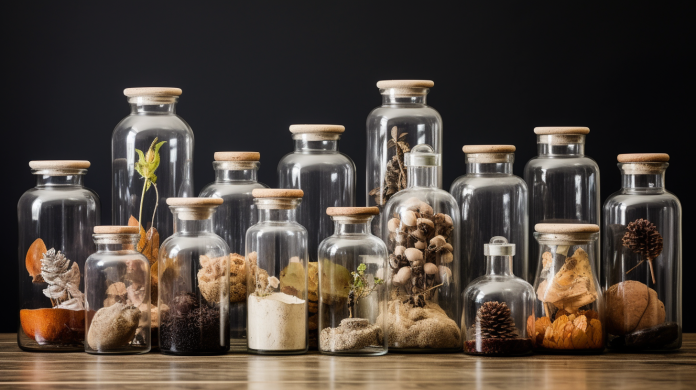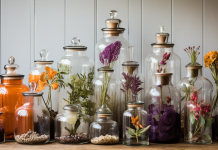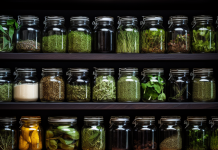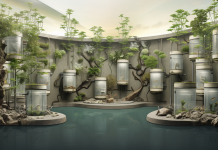Creating an Indoor Herb Jar Garden for Autumn
Selecting the Perfect Spot for Your Indoor Herb Garden
As autumn sets in, it's the ideal time to bring a touch of greenery and flavor into your home with an indoor herb jar garden. Whether you're an experienced gardener or just starting out, finding the right location indoors is crucial for your herb garden's success. In this guide, we'll explore key factors such as sunlight, temperature, space, watering, and potential pests, tailored specifically for an indoor herb garden during the autumn season.
Assessing Indoor Sunlight during Autumn
During the autumn months, the angle and intensity of sunlight indoors change. It's essential to evaluate your indoor space's sunlight conditions before setting up your herb jar garden. Understanding these conditions is vital as they directly affect the growth and health of your herbs.
Sunlight: Determine which areas of your home receive the most sunlight during autumn. While the sun's intensity may be lower than in the summer, herbs still need a good amount of light. Choose spots that get at least 4-6 hours of indirect sunlight daily. This will normally be on the south facing side.
Caveat: Many herbs require four or five hours or more of direct sunlight. Rotating the container every few days may help, as will southern facing locations. Ultimately your indoor herb garden may require artificial lighting to prosper.
Artificial Lighting: In the absence of sufficient natural light, consider using grow lights specially designed for indoor gardening. These can supplement sunlight and provide your herbs with the necessary light during autumn.
Possible Locations
Indoor herbs in jars can thrive in various locations in your home, provided they receive the right amount of light and temperature conditions. Here are some suitable indoor locations for growing herbs in jars:
1. Kitchen Windowsill: A sunny windowsill in your kitchen is an ideal spot for growing herbs in jars. Most herbs require at least 4-6 hours of direct sunlight daily, and the kitchen windowsill often provides the necessary light.
2. South-Facing Windows: If you have a south-facing window with good sunlight exposure, it's an excellent choice for growing herbs. South-facing windows receive the most sunlight during the day.
3. East-Facing Windows: East-facing windows get morning sunlight, which is generally milder and can be suitable for herbs that prefer indirect light and so the indirect light in the morning may be sufficient.
4. Balcony or Patio: If you have a balcony or patio with sufficient sunlight, you can place your herb jars there. Just ensure they're protected from harsh elements like frost, strong winds, heavy rain.
5. Indoor Herb Garden Shelf: You can set up a dedicated indoor herb garden shelf or rack near a window with good light. This allows you to grow multiple herbs in jars or pots in one convenient location.
6. Under Grow Lights: If you don't have access to adequate natural light, consider using artificial grow lights. You can place your herb jars under full-spectrum LED grow lights to provide them with the necessary light for growth.
7. Hanging Herb Garden: Install a hanging herb garden near a window, where the herbs are suspended in jars or containers. This can be a creative and space-saving way to grow herbs indoors.
8. Bathroom Windowsill: Some herbs, such as mint, can tolerate lower light conditions. If you have a bathroom with a window, it can be a suitable spot for growing these herbs.
9. Movable Plant Stand: If you want to really go over the top consider using a movable plant stand with wheels.
10. Conservatory: If you are fortunate enough to have a conservatory it is an ideal location. The jars can be arranged to allow the sun loving herbs the most sunlight.
When choosing a location for your indoor herb jars, keep the following tips in mind:
- Monitor the temperature, as most herbs prefer room temperatures between 60°F to 75°F (15°C to 24°C).
- Rotate your herb jars regularly to promote even growth, as plants tend to lean toward the light source.
- Consider the convenience of the location for watering and harvesting.
Choosing Herbs for Indoor Autumn Gardening
For your indoor herb garden in autumn some herbs are well-suited for indoor conditions and can thrive during this season. Here are some herbs that are ideal for autumn indoor gardening:
Basil: A fragrant herb that does well indoors and can be used in various dishes.
Parsley: An herb that thrives in indoor containers and adds a fresh flavor to your meals.
Chives: Easy to grow indoors, chives enhance the taste of many dishes.
Mint: Mint varieties, such as spearmint or peppermint, can be grown indoors and used in teas and recipes.
Timing
Basil: Basil is a relatively fast-growing herb. You can typically expect to see seedlings emerge within 5-10 days after planting. It can be ready for harvesting in about 6-8 weeks from sowing.
Parsley: Parsley seeds can take longer to germinate, usually within 14-21 days. It can take 2-3 months or more to reach maturity, depending on the variety. Flat-leaf parsley tends to grow faster than curly-leaf parsley.
Chives: Chives are known for their rapid growth. They often sprout within 7-14 days after planting and can be harvested in about 3-4 weeks. Chives are perennial, so they continue to grow year after year.
Mint: Mint is known for its rapid growth. Seedlings usually emerge within 7-14 days, and it can be ready for harvesting in about 6-8 weeks. Mint is a perennial herb.
Ensuring Proper Watering and Drainage
Proper watering and drainage are key to maintaining your indoor herb garden during autumn. Here's what you should keep in mind:
Autumn Watering: During autumn, the air is often drier indoors. Be mindful of your herbs' water needs. Water them when the top inch of soil feels dry to the touch. Herbs generally prefer slightly drier conditions compared to other plants. Typically, you may need to water once every 1-2 weeks, but adjust based on the moisture level of the soil.
Given the limited access via the neck of the jar a soil moisture meter is a useful tool. These are low cost and start at a few pounds / dollars each.
Drainage: Ensure that the pots or jars you use for your herbs have adequate drainage. Herbs do not like to sit in waterlogged soil, which can lead to root rot. The easiest way to do this is to use a layer of small stones or gravel at the bottom before adding soil.
Keep an Eye on the Plants: Pay attention to how your herbs are responding to your care. If you notice signs of stress like wilting or yellowing leaves, adjust your watering habits accordingly.
Preventing and Addressing Indoor Pests
In an indoor herb garden, it's important to prevent and address potential pests. Even during autumn, pests can find their way indoors. Here are some common indoor herb garden pests and how to deal with them:
| Pest | Identification | Protection Measures |
|---|---|---|
| Aphids | Small, soft-bodied insects on your herbs | Use insecticidal soap or neem oil spray. |
| Fungus Gnats | Small flies near your herbs | Let the soil dry between waterings and use yellow sticky traps. |
| Spider Mites | Tiny, web-spinning creatures | Increase humidity and use neem oil or insecticidal soap. |
Aphids need warmth to flourish, so in the garden this limits their lifecycle to spring and summer. Whilst neem oil spray is considered organic not all neem oil products are the same, and the degree of “organic” or “natural” status can vary. Some neem oil products may contain additional ingredients or additives that could affect their organic status.
If you're specifically looking for a certified organic neem oil product, check for labels or certifications from reputable organic certifying agencies. These certifications help ensure that the product meets organic standards and contains only approved ingredients.
Neem oil is extracted from the seeds of the neem tree using a mechanical or cold-pressing process. Ideally it does not (should not) involve synthetic chemicals or additives in its production.
Key Takeaways
- Evaluate the indoor sunlight conditions during autumn.
- Choose herbs that thrive in indoor environments.
- Ensure proper watering and drainage for your indoor herb jars.
- Be vigilant in preventing and addressing potential indoor pests.
Conclusion
In conclusion, setting up an indoor herb jar garden during autumn is a wonderful way to enjoy fresh herbs right in your home. Begin by assessing the available indoor sunlight conditions, keeping in mind the changing angles of the autumn sun. Select herbs that thrive indoors and are suitable for the autumn season.
Maintain a proper watering schedule, and ensure you do not over water. Be mindful of potential indoor pests and take steps to address them promptly. With these considerations in mind, you can create a thriving indoor herb garden that could enhance your autumn culinary adventures. Happy herb gardening!
Please see our supporting articles:
Common Challenges and Solutions for Herbs in Glass Jars
Glass Jars for Herb Cultivation
Resources
University of Vermont: Indoor Herb Gardening (PDF)



